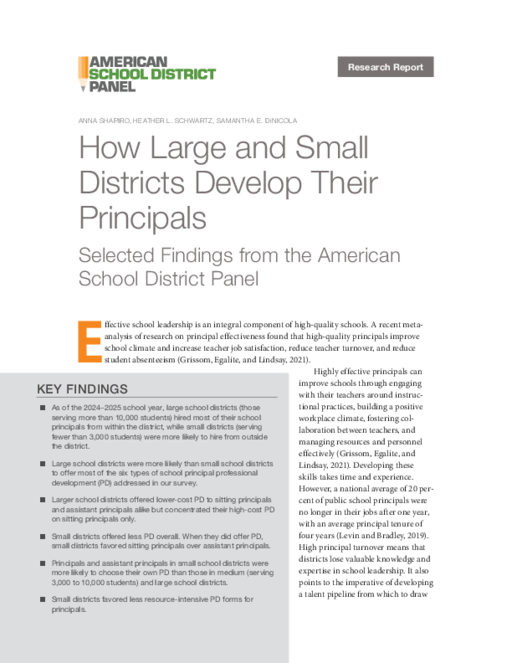Breadcrumb
- Wallace
- Reports
- How Large And Small Districts De...
How Large and Small Districts Develop Their Principals
Selected Findings from the Spring 2025 American School District Panel Survey

Summary
How we did this
In Spring 2025, the authors surveyed 207 American School District Panel member districts about principal pipelines, preparations, and supports. Researchers asked about six types of talent development, ranging from less resource-intensive offerings to more resource-heavy offerings to learn how districts invest in their pipelines, both for assistant and sitting principals. They also compared responses from large and medium districts with responses from small districts.
Hiring, developing, and retaining highly effective principals is a high priority for any school district. Research tells us that aligned, comprehensive principal pipelines can help districts find and support principals who make a positive impact on students, teachers, and schools. Developing pipelines, or systems for developing a steady stream of school leaders, requires investment and commitment from districts.
While a strong evidence base exists around the key components of principal pipelines, the prevalence of those practices remains less understood. This report uses data from a Spring 2025 survey of member districts of the American School District Panel to better illuminate the types of professional development (PD) districts offer and to whom. The survey asked school districts about six types of talent development, ranging from less resource-intensive offerings (paid time for conferences; professional learning communities; trainings and workshops) to more resource-heavy offerings (principal supervisors, principal mentors, and professional coaching).
The findings in the report show that large school districts (those serving more than 10,000 students) differ from small (those serving fewer than 3,000 students) districts when it comes to professional development offerings in a number of key ways:
- The report found that large school districts were more likely to hire from within the district, while small and medium districts were more likely to hire from outside the district.
- Large school districts were more likely than small districts to offer most of the six PD types addressed in the survey.
- Small districts were more likely to offer PD to sitting principals than assistant principals. The researchers hypothesize that this is because small districts primarily hire new principals from outside the district and would rather use their limited resources on sitting principals.
- Small districts also offered more lower-cost PD opportunities to their principals.
- Large school districts offered lower-cost PD to both principals and assistant principals, but concentrated higher-cost PD to sitting principals only.
- Principals and assistant principals in small districts were more likely to choose their own PD than those in medium and large districts.
The researchers note that some schools in small districts do not have assistant principals, thus making this a less-established position for districts to invest in.
The findings in this report have implications for state policymakers who are grappling with school leadership shortages by highlighting where districts typically find new principals and how they are developing their school leaders. Universities with pre-service leadership training programs may also apply these findings by addressing gaps in PD offered by districts through their program offerings.

High principal turnover means that districts lose valuable knowledge and expertise in school leadership. It also points to the imperative of developing a talent pipeline from which to draw new school leaders.
Key Takeaways
- One factor that may influence district decisions about investments in PD for principals of all levels is how often they hire principals from within the district. Larger school districts who hire from within may be more likely to invest in developing their school leaders, particularly assistant principals.
- More than 75 percent of districts surveyed would like to offer more PD to both sitting principals and assistant principals. However, small districts were less interested in offering more high-cost PD such as mentoring and professional coaching to their assistant principals than large and medium districts.
- Districts tended to offer the same PD to both novice and veteran principals with the exception of mentoring programs, which were more likely to be offered to novice principals than veteran principals.

